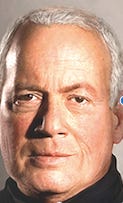By David E. Dix
An illustration by a Kent artist will feature on a new United States first class postage stamp which debuts in June.
The illustration is of the new James Webb Space Telescope, the successor to the Hubble Orbital Telescope which has expanded our knowledge of the universe. Launched into space last December, the new telescope was parked a million miles away in a position where the gravitational forces of the earth and the sun are equal.
After:Streetsboro hopes to bring PARTA bus lines to the city to help with labor shortages
After:LG Chem inaugurates two new factories in Ravenna which should employ at least 100 people
The artist is James Vaughan, a graduate of Roosevelt High School (class of 1973), who spent a year at Hiram College before continuing his studies at Columbia College in Chicago, a private institution of higher education specializing in the arts.

Always interested in science and technology, Vaughan has developed a strong reputation for using art to depict subjects that, to many, might be intimidating. Science Magazine, for its February 2016 edition, contacted Vaughan to cover an article the magazine was developing on the James Webb Space Telescope that NASA had contracted with Northrop Grumman and Ball Aerospace & Technology to build. The illustration he created will go on the new postage stamp.
The telescope is named after the American NASA administrator who served during the space race with the Soviets in the 1960s. Because it was under construction in 2016, Vaughan had to fashion its magazine illustration to from technical drawings that Northrop Grumman shared with him. The cover of Science Magazine, the basis for the new postage stamp, shows a device attached to a solar panel the size of a tennis court. Using solar power, the telescope will use infrared photography to peer deep into space. It will capture images further than anyone has ever seen and help unravel the mysteries of the universe.
After:On the Way: Tribute to those who make Portage greener, healthier and safer
After:On the Way: Swept Away by a Reception for Ohio House Speaker Robert Cupp
Amazingly, Vaughan had to reinvent himself to do illustrations like the James Webb Space Telescope due to changing art technology. For much of his career, relying on photography, he specialized in fashion photography in Chicago.
He eventually returned to Kent, to reside closer to his older siblings. A sister, Ginger Vaughan, taught art at Kent State. Benefiting from college knowledge, Vaughan self-taught Photoshop and other applications and began working from his home on North Willow Street. The demand for his services has increased. When the new James Webb Space Telescope stamp is issued, Vaughan’s business activity could get even stronger.
I asked Vaughan to name a teacher who had been a major influence. He quickly mentions Ken Gessford, Roosevelt’s now retired art teacher, as well as several social science professors.
Vaughan’s ability with science subjects may come naturally. His father, the late Paul Vaughan, a Purdue-trained engineer, served as director of research at Goodyear, eventually leaving to found FILMCO in Aurora.
Edith Chase Colloquium

Elsewhere, we all have the opportunity to learn what we face in northeast Ohio if we are to improve our water quality which has been, and continues to be, damaged by various forms of pollution. as well as by artificial impermeable surfaces where water accumulates and stagnates.
Kyle Dreyfuss-Wells, general manager of the Northeast Ohio Regional Sewer District, will present the Edith Chase Symposium on Friday, May 20 at Kent State’s College of Architecture and Environmental Design. The 7 p.m. presentation is free and open to the public.
Friday’s program will be followed Saturday at 4 p.m. with “Birds of the Cuyahoga,” a gathering of poets reading original poetry at Wick Poetry Center Plaza. Kent State Professor Emeritus Bob Heath, a molecular biologist who organized the program, argues that science and the arts can join forces to boost environmentalism.
David E. Dix is a former editor of the Record-Courier.